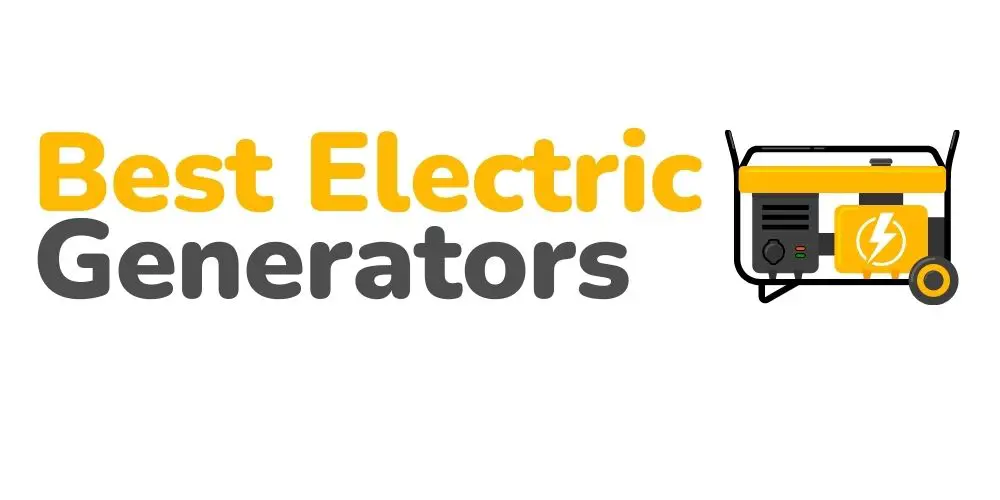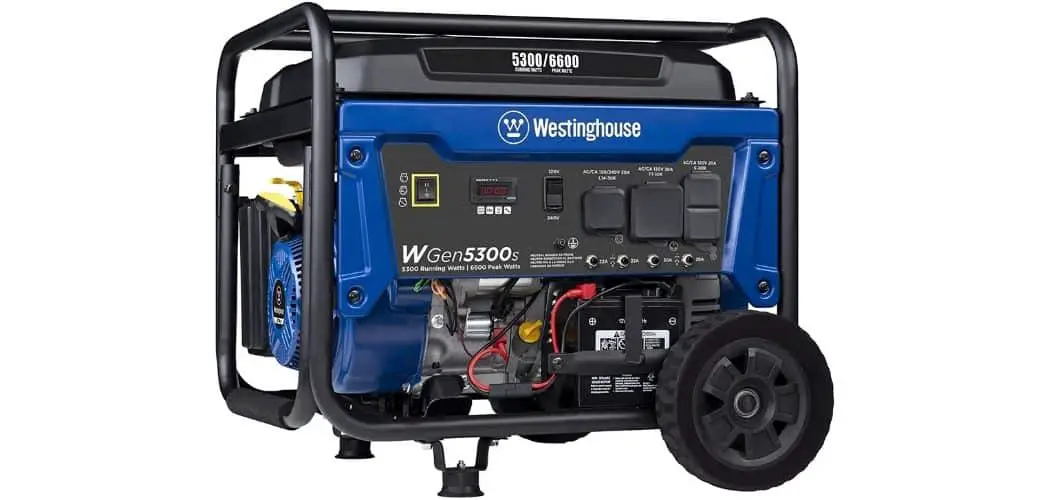Generators come in all sizes, from small to those that can power entire apartments. But for a regular home, a 5,000-watt generator has a lot to offer. The 5,000-watt generator can power essential appliances at your home, such as a refrigerator or a sump pump. But a 5,000-watt generator is not limited to houses only. They can be used at work sites or in RVs.
So, what will a 5000-watt generator run? Let’s find out.
Understanding Generator Wattages – Running wattage Vs. Starting wattage
When you buy a generator, you’ll be hearing Running Watts, Starting Watts from everyone. So, what exactly are these running or starting watts. These are the different wattage values produced by the generator or consumed by appliances.
Starting watts for a generator are those peak wattages that a generator can produce for a few seconds. At the same time, a generator can produce running watts continuously. Now that we know what these are, what is the need to have two different wattage values?
When an electric motor starts, it consumes a considerable amount of current for its magnets to pull each other. This high consumption is called ‘starting watts.’ Once the motor starts to spin at a higher speed, the current consumption reduces to ‘running watts.’ The starting current can be as high as 5 times the running current. For example, drills have 800 running watts, but their starting watts are as high as 2500 watts.
The generator cannot run at its maximum for a long time. It can even catch fire because of high current consumption. That’s why generators have circuit breakers to prevent overload. These circuit breakers are specially designed for generators that allow high current for short periods. That way, these generators can produce high wattages to run motors but still manage to keep themselves from any damage.
Calculate Appliance Power Requirements
How many appliances can a 5000-watt generator power at once? To answer this, we’ll have to know the power draw of each appliance. Power draw is usually mentioned on the appliance. You’ll find it near the power cord.
Most devices have their consumption mentioned in watts. You can find it in amperes and volts in some too. And sometimes, only the amps are mentioned on the appliance. You’ll have to convert it to watts to calculate. For this, multiply the amps with either 120 or 240 volts.
Don’t Forget Start-Up Power
When you have a limited power supply, such as a generator, you need to make sure you’re not overdoing it. For this, you’ll have to consider the starting watts or startup power of appliances. This is the extra starting power required by on and off cycling appliances. It can be as much as three times the running watts. For example, the refrigerator only consumes 700 watts, but the power consumption can go as high as 2,300 watts when it’s started. That’s why, when considering appliances to use on the generator, you’ll have to consider these starting watts.
If you fail to account for this extra startup power, the generator’s circuit breaker will trip when capacity exceeds the limit.
What appliances can a 5000-watt generator run?
A 5,000 watts generator is powerful enough to run most of the appliances without any problems. But this generator cannot power all the devices at once. So, you will have to do some math to find out what a 5,000-watt generator can run?
For this, you’ll have to follow some steps:
- Make a list of all the electric appliances you’ll be running on a generator.
- Write down their running watts and starting watts
- Add up the running watts of these appliances.
- Find the appliance with the highest starting watts.
- Add these starting watts with the running watts’ total.
This final number will represent the surge watts. You’ll have to make sure that it lies under the generator’s rated watts.
Here’s a list of some appliances with their rated watts:
| Appliance | Running Watts | Starting Watts |
| Dishwasher | 1,500 watts | 1,600 watts |
| Ceiling Fan | 60 watts | 75 watts |
| Vacuum Cleaner | 220 watts | 200 watts |
| Washing Machine | 1,200 watts | 2,300 watts |
| Laptop | 50 watts | – |
| Hammer Drill | 1,050 watts | 3,200 watts |
| TV | 90 watts | – |
| Space Heater | 800 watts | – |
| Toaster | 900 watts | – |
Powering Your Home with a 5,000-watt Generator
The 5000-watt generator is suitable for powering a home during blackouts. But, it’s not powerful enough to power all the appliances at once. That’s why you should be careful not to increase consumption more than rated. Next, we’ll look through all the devices present at a typical home and check whether they can be used on a generator.
Some of the most power-hungry appliances found at your home would be:
- Central Air Conditioning System: 3,500 to 6,200 watts (Surge Watts from 8,000 to 12,500)
- Central Heating System: 5,200 or higher, depends on the size.
- Electric Stove: 1,800 watts
- Refrigerator: 600 watts (Surge Watts 2,000 to 2,500)
- Space Heater: 700 watts to 1,600 watts.
- Sump Pump: 750 watts (Surge Watts from 1,450 to 3,000)
- Well Pump: 1,000 watts (Surge Watts from 2,100 watts to 4,000)
These are some of the essential appliances that you may need to power with your 5,000 watts generator. However, they have high power consumption, and the starting watts make them some heavy-load machines. Using a device that’s running watts and starting watts add up to more than 5,000 watts will damage your generator.
A tip for using pumps with a generator is to start the pumps before other appliances. They have high surge watts but lower running watts. Once they start up, you can turn on different machines and use them simultaneously.
Powering a Work Site with a 5,000-watt Generator
5,000 watts seems like a huge number, but it’s merely usable at work sites. It’s because the worksite relies on power tools, electric saws, and drills. Since these tools use electric motors, their running watts are high. And the starting watts are up to 4 times higher than the running watts.
The electricity consumption of some power tools is listed below:
- Bench grinder: 1,450 watts (Surge watts 2,600)
- Chainsaw: 1,500 watts
- Circular saw: 1,500 watts (Surge watts 2,400)
- Electric drill: 700 watts
- Electric Leaf blower: 1,100 watts
- Table Saw: 1,900 watts (Surge Watts 4,300)
- Portable Air compressor: 1,650 (Surge Watts 4,000 to 4,500)
A 5,000 watts generator is suitable for one or two power tools when considering surge watts. But if you want to use more power tools, you’ll be limited by the generator. This limitation can be challenged with the help of new pneumatic tools. Air compressors power them that a generator can use. But even then, the 5,000 watts generator fails to get the job done if you have a large worksite.
Powering an RV with a 5,000-watt Generator
RVs are designed to consume low power because RVs rarely have utility power, unlike these other places we talked about. Instead, they rely on batteries to power appliances. That’s why the devices used in RVs, even if it’s an air conditioning system, don’t use that much electricity. So, even a 3,000 watts generator would be suitable for smaller RVs.
But, using a 5,000 watts generator in your RV provides you ease. You won’t have to balance the power by using limited appliances. You’ll be free to power the whole RV’s electrical grid. It can power your AC unit, kitchen appliances, lights, and other appliances easily.
Benefits of using a 5000-watt generator
A 5,000 watts generator is suitable for running most essential appliances, as long as you’re using one at a time. Of course, you’ll limit your usage with them when using them in homes or worksites. But when it comes to RVs, these generators give you a free hand to use all the electronics.
In houses or at work sites, these generators have their benefits. If you want to power essential appliances at your home, such as the freezer or the sump pump. You can connect your generator to these with the help of extension wires. Thus, you won’t have to power unnecessary appliances. Whereas on the worksites, if you have to use power tools at remote sites, the 5,000 watts generators are perfect. These can be carried at remote areas and used to power a drill or two.
Will a 5000-watt generator run a whole house?
Even though 5,000 watts seems a lot, it’s not even half the watts your house uses when you’re using all the appliances. For example, a central heating unit consumes as much as 5,200 watts, only the running watts. When you combine this with other electric devices, you get a total of 15,000 watts to 20,000 watts. So, a 5,000-watt generator cannot run a whole house.
Will a 5000-watt generator run a window air conditioner?
Yes, a 5,000-watt generator can run a window AC. They consume around 1,200-1,500 watts. Using a window AC leaves you with enough watts to power other appliances simultaneously. Although, you’ll have to make sure that you’re not exceeding the generator’s limit. So make sure to keep an eye on the starting watts of such appliances.
Will A 5000-Watt Generator Run a Central Air Conditioning?
A Central Air Conditioning unit requires anywhere from 3,500 to 6,200 watts. With that, the additional starting watts can be from 8,000 to 12,500 watts. This load is above the 5,000 watts generator’s rated watts. So, it cannot run a central air conditioning unit. However, you can use a space heater for your home too.
How many amps does a 5000-watt generator provide?
A 5,000 watts generator can provide different amps depending on the supply. For example, if your appliances consume 120 volts, it’ll provide 41 amps. And if they require 240 volts, then the generator can deliver 20 amps.
Will A 5000-Watt Generator Run A Sump Pump?
Yes, the 5,000 watts generator is capable of running a sump pump. Sump pumps consume around 750 watts. And their surge watts can be as high as 3,000 watts. So, make sure to power the sump pump before powering other appliances.
Conclusion
A 5000-watt generator is a lot of power, or not, depending on your usage. However, if you plan your use carefully, the generator can be utilized perfectly. For this, make sure to keep an eye on the running and starting wattage. Summing up the appliances’ wattage will give you an estimate. This estimate should be at least 10% lower than the 5,000-watt output of the generator.
If you own an RV, then the 5000-watt generator would be perfect for it and enough to power all appliances in an RV.


